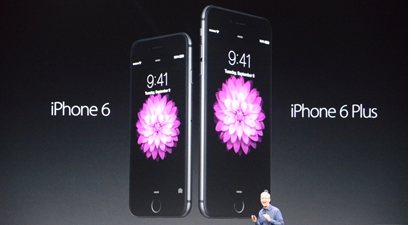 We all knew they were coming, and here they are: Apple’s new 4.7-inch iPhone 6, and the new 5.5-inch iPhone 6 Plus. The new larger iPhones are Apple’s resignation to the growing popularity of “phablet” phones. Steve Jobs — who famously dissed bigger phones — may be turning in his grave.
We all knew they were coming, and here they are: Apple’s new 4.7-inch iPhone 6, and the new 5.5-inch iPhone 6 Plus. The new larger iPhones are Apple’s resignation to the growing popularity of “phablet” phones. Steve Jobs — who famously dissed bigger phones — may be turning in his grave.
Apple CEO Tim Cook revealed the devices today at the company’s annual iPhone launch event, held this year in Cupertino.
At 6.9mm and 7.1mm thick, the new iPhones are thinner than previous models, and have narrower bezels around the screen, which curves down toward the bezels. The “Retina Display” (HD) resolution on the iPhone 6 is 1334 x 750 pixels (326 ppi), and the resolution on the iPhone 6 Plus is even sharper at 1920 x 1080 (401 ppi). There’s no sapphire glass as was rumored (that’s on the Apple Watch), but Apple says the new iPhone’s glass is now ion-strengthened, and has an improved polarizer for better visibility.
We’ve rounded up some of the best iPhone 6 hands-on previews posted online so far, which you’ll find further down in this story.
The guts
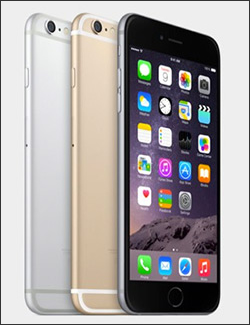 Inside, the iPhone 6 is powered by Apple’s new 64-bit A8 processor, which the company says is about 25 percent faster and up to 50 percent more efficient than the 64-bit A7 chip in the iPhone 5S. Apple promises you up to 14 hours of talk time — a 40 percent increase over the iPhone 5S — and 10 days of standby. But you’ll still only get about 10 hours of web browsing time over mobile networks, and 11 hours of video playback, which is just an hour more than the 5S.
Inside, the iPhone 6 is powered by Apple’s new 64-bit A8 processor, which the company says is about 25 percent faster and up to 50 percent more efficient than the 64-bit A7 chip in the iPhone 5S. Apple promises you up to 14 hours of talk time — a 40 percent increase over the iPhone 5S — and 10 days of standby. But you’ll still only get about 10 hours of web browsing time over mobile networks, and 11 hours of video playback, which is just an hour more than the 5S.
The A8 is assisted by the M8 motion co-processor, which improves on the M7 found in the iPhone 5S. Unlike the M7, the M8 can tell if you are running or cycling, can track how many flights of stairs you climb, and can measure elevation by tracking air pressure.
Those advanced motion sensor features aren’t unique to the iPhone 6 though — Samsung, LG and others have already added them to their recent high-end phones.
For connecting to the world, you’ll find WiFi of the popular 802.11ac flavor, plus LTE network connectivity at up to 150Mbps where supported. The iPhone 6 supports more than 20 LTE bands, which Apple claims is more than any other smartphone. You can make calls over both LTE and WiFi if your wireless carrier supports it.
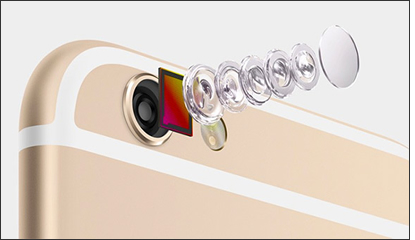 New camera features
New camera features
On the camera side, both new iPhone 6 models still have an 8-megapixel, f/2.2 aperture lens rear camera, and sadly, Apple has only included optical image stabilization on the larger iPhone 6 Plus (the 4.7-inch model uses digital image stabilization).
But like HTC, Apple promises better photos from new features, not from megapixel count. Apple says the new camera lens lets in 81 percent more light than before, similar to the HTC One. The iPhone 6 also offers phase detection for quicker focusing, a new imaging chip with better noise reduction and improved colors, and single-shot high dynamic range (HDR). Apple also promises faster face detection, improved blink and smile detection, and advanced processing algorithms that it claims improve detail, contrast, and sharpness. Panoramic pictures can now be up to 43 megapixels.
Video capture is also improved: you can now record 1080p video at 30 or 60 frames per second, and slow-motion clips at up to 240 frames per second instead of the previous 120.
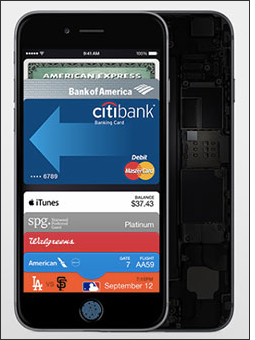 NFC, Apple Pay, and iOS 8
NFC, Apple Pay, and iOS 8
As anticipated, the iPhone 6 now includes an NFC (near-field communication) chip to support for Apple’s new Pay mobile payments service at supported credit card readers. While Samsung and other major phone makers have already added NFC to their recent phones, Apple has until now relied on Bluetooth for its Passbook and iBeacon platforms.
Your Apple Pay purchases will be authenticated through the iPhone 6’s TouchID sensor, and each iPhone 6 has a secure element built inside it to store your credit card data. Apple Pay supports American Express, MasterCard, and Visa, as well as the six largest banks in the US. Apple says 22,000 retailers will also support the service, including Subway, McDonalds, Walgreens, Duane Reade, Macy’s, Bloomingdale’s, Staples, Whole Foods, and all of Apple’s own stores. App developers can also integrate Apple Pay into their apps for one-click purchases.
As you might guess, the iPhone 6 comes pre-installed with iOS 8, which Apple unveiled at its developers conference in June. The new operating system improves on iOS 7 in a number of ways, including improved integration for third-party apps and Apple’s new HealthKit service.
If you don’t plan on buying an iPhone 6, you’ll be able to download iOS 8 starting September 19 for every iPhone from the 4s on, every iPad starting with the iPad 2, and the fifth-generation iPod touch.
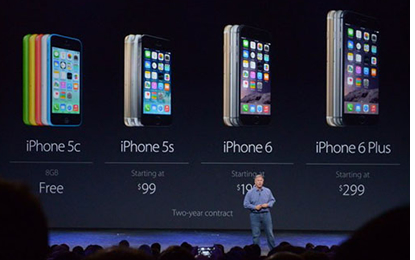 Cost and availability
Cost and availability
The iPhone 6 will come in three colors — gold, silver, and grey. Preorders start this Friday, September 12th, with shipping in “several countries” starting on the 19th. Apple says the iPhone 6 will be available in 115 countries by the end of the year.
For the 4.7-inch iPhone 6, on-contract pricing starts at $199 for a 16GB model, while 64GB and 128GB versions will be available for $299 and $399, respectively. The 6 Plus will cost $299, $399, and $499 respectively. Apple has killed off the 32GB model, perhaps because expecting better sales for the other models.
iPhone 6 vs. the competition
If you aren’t fully tied to the Apple ecosystem, you’re wondering how the iPhone 6 and 6 Plus compares to the latest top Android smartphones. While the iPhone 6 isn’t available yet for review, Greenbot has put together a handy spec-by-spec comparison of the iPhone 6 versus the new Moto X, Galaxy S5, LG G3, and HTC One M8.
And if you’re looking at the iPhone 6 Plus, Greenbot also has a spec-by-spec comparison of the iPhone 6 Plus versus the new Galaxy Note 4, LG G3 Stylus, and LG G Flex.
iPhone 6 hands-on previews
For some hands-on photo and video time with the iPhone 6, check out Engadget and Gizmodo. For some hands-on time with the iPhone 6 Plus, check out Engadget, Gizmodo, and The Verge. Finally, AppleInsider and Slashgear have each posted a hands-on of both phones.
And the Apple Watch is here
Apple as expected also announced the Apple Watch, a smart wristwatch that wirelessly connects to iPhones. The Apple Watch features many iPhone functions — including voice calling, texting, email, Siri, and Apple HealthKit — among others. You can check out photos, specs, and the best hands-on previews of the Apple Watch in our hands-on roundup.




